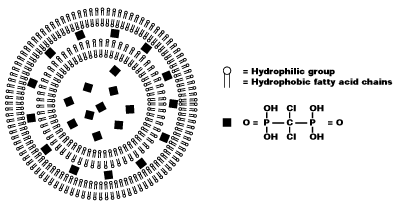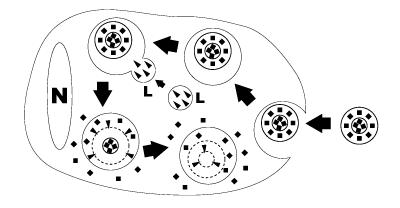ClodronateLiposomes.org |
|||
Mechanism |
|||
Clodronate is not a toxic drug in itself and liposomes (if prepared of phosphatidylcholine and cholesterol) are not toxic either. Free clodronate will not easily pass phospholipid bilayers of liposomes and cell membranes but liposomes are eagerly swallowed by macrophages. The implication is that clodronate, once delivered into phagocytic cells using liposomes as vehicles, will not escape from the cell. After disruption of the phospholipid. bilayers of the liposomes under the influence of the lysosomal phospholipases in the macrophage, the drug, which is dissolved in the aqueous compartments between the liposomal bilayers, is released into the cell. The clodronate is accumulated intracellularly and after exceeding a threshold concentration, the cell is irreversibly damaged and dies by apoptosis (J. Immunol. Meth. 193: 93-99, 1996). Free clodronate, e.g. released from dead macrophages, has an extremely short half life in the circulation. It is removed from the circulation by the renal system. Naturally, the approach can only be successful when the liposomes are able to reach the macrophages which have to be eliminated. Vascular barriers (capillary walls) can not be crossed by liposomes. In short, macrophages can be depleted in the liver (Kupffer cells), spleen (different macrophage subpopulations), lung (alveolar but not interstitial macrophages), peritoneal cavity, lymph nodes, joints (phagocytic synovial lining cells) and testis if liposomes are adequately administered. (See reviews : J.Immunol.Meth. 174; 83-93, 1994. & Trends in Biotech. 15; 178-185, 1997 and relevant literature under: Manuscripts). Illustrations
Above: Clodronate-liposomes. Liposomes are artificially prepared spheres, consisting of concentric phospholipid bilayers, seperated by aqueous compartments. They form, when phospholipid molecules are dispersed in water. Part of the aqueous solution, together with hydrophilic molecules which have been dissolved in it, such as the bisphosphonate Clodronate (black squares; see also structural formula) are encapsulated during the formation of the liposomes. 
Above: Macrophage 'suicide'. Liposomes, encapsulating the Clodronate molecules (squares), are ingested by macrophages via endocytosis. After fusion with lysosomes (L) containing phospholipases (arrowheads), the latter disrupt the bilayers of the liposomes. The more concentric bilayers are disrupted, the greater is the Clodronate release within the cell. The cells are killed by Clodronate through apoptosis. (N = nucleus of the macrophage). |
|||
Copyright (C) 2006 Dr. Nico van Rooijen - All rights reserved. |
|||
